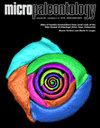Nephrolepidina and unispiralled Miogypsinidae from the Oligo-Miocene toe-of-slope succession of Gran Sasso (L'Aquila, Central Apennines - Italy): biometric and evolutionary remarks
IF 1.6
4区 地球科学
Q3 PALEONTOLOGY
引用次数: 3
Abstract
A biometric analysis was performed on twelve Nephrolepidina and ten Miogypsina and Miogypsinoides populations, coming from the Tre Valloni section, an Oligo-Miocene calcarenitic toe-of-slope succession outcropping in the southern sector of Gran Sasso (L'Aquila, Central Apennines - Italy). Miogypsina populations are investigated applying two essential parameters, i.e., the number of the nepionic chambers and the protoconch diameter. Previously detected evidences of reworking in the same material suggested to use some cautions to avoid misleading results. A mixed typological-statistical methodology is used, leading from starting "disordered" assemblages to final "virtual but reliable" populations, cleaned up from reworked specimens, in order to implement the accuracy of the biostratigraphic results. This goal is reached for the lower part of the succession only. According to the biometric limits proposed for the various chronospecies in the recent literature, the resulting populations are referred to Miogypsinoides ex. interc. complanatus-formosensis up to Md. bantamensis, and to Miogypsina basraensis up to M. ex. interc. gunteri-tani. This sequence of taxa, in general, is in agreement with the principle of nepionic acceleration, with a progressive reduction in the average number of nepionic chambers (X), arranged in a single spiral, just peculiar in the more primitive populations. Miogypsinoides bantamensis and Miogypsina basraensis are recognized biometrically for the first time in the Central Apennines. Nephrolepidina populations are investigated applying the recently introduced biometry of the fifth stage of the neanic equatorial chamberlets, supplying additional data about parameters and factors that had already demonstrated to have taxonomic-biostratigraphic significance. The biometric analysis of the embryo-nepionic stages was performed as an integration of the data obtained in a previous study, excluding the uppermost samples in which Nephrolepidina is clearly reworked, being characterized by primitive morphology, i.e., almost isolepidine embryo, few adauxiliary chamberlets, and ogival equatorial chamberlets. The neanic data evidence that the "Degree of stolonic distalization" (Factor FD5) and the "Shape Index" (Factor SI5), at the 5th nepionic stage of the population have a very good fitting with the previously evidenced Neanic acceleration, as the overall trend to modify the shape of the equatorial chambers, connected with a gradually more distal position of the radial stolons. Unispiralled Miogypsina, associated with Nephrolepidina at an advanced evolutionary stage, suggest a continuous reworking of primitive miogypsinids, without an involvement of more evolute bispiralled forms. The biostratigraphic assessment of the Venacquaro and Glauconitic Calcarenite formations is improved, assigning the Venacquaro Formation to the Chattian-lowermost Aquitanian (SBZ22B-basal SBZ24) and the base of the Glauconitic Calcatenite to the Aquitanian (SBZ24 p. p.). The investigated sedimentary succession was deposited along a slope to toe of slope characterized by a mixture of taxa displaced from shallow-water environments and reworked primitive specimens eroded along channels.新近至中新世Gran Sasso (L'Aquila,中亚平宁-意大利)坡脚演替中的肾鳞目和单尖目Miogypsinidae:生物特征和进化评论
对意大利Gran Sasso (L’aquila,中亚平宁)南段渐新世-中新世钙屑岩坡脚演替露头的Tre Valloni剖面的12个Nephrolepidina、10个Miogypsina和Miogypsinoides种群进行了生物特征分析。采用两个基本参数,即海螺腔的数量和原海螺直径,对Miogypsina种群进行了研究。先前在同一材料中发现的返工证据建议使用一些谨慎措施以避免误导性结果。使用混合类型-统计方法,从开始的“无序”组合到最终的“虚拟但可靠”种群,从重新加工的标本中清理出来,以实现生物地层学结果的准确性。这一目标只适用于继承权较低的部分。根据最近文献中提出的各种时间物种的生物特征限制,所得到的种群被称为miogypsinides ex. interc。直到班塔马氏斑胸蛾和直到外interc斑胸蛾的basramiogypsina。gunteri-tani。总的来说,这个分类群的序列与nepionic加速的原理是一致的,nepionic室的平均数量(X)逐渐减少,排列成一个螺旋状,这在更原始的种群中是特有的。bantamensis miogypsinides和basraensis miogypsinensis在亚平宁中部首次被生物识别。本文应用新近引入的新赤道腔室第五期生物计量学方法对肾鳞虫种群进行了研究,提供了关于已经证明具有分类-生物地层学意义的参数和因素的额外数据。胚胎-肾腺阶段的生物特征分析是作为先前研究数据的整合进行的,排除了最上面的样本,其中肾腺被明显改造,其特征是原始形态,即几乎是异肾腺胚胎,少数辅助腔室和卵母赤道腔室。neanic数据表明,种群第5 neanic阶段的“匍匐体远化程度”(FD5因子)和“形状指数”(SI5因子)与先前证明的neanic加速度有很好的拟合,这是赤道室形状改变的总体趋势,与径向匍匐体逐渐向远端移动有关。单螺旋形Miogypsina在进化的高级阶段与肾鳞翅目(Nephrolepidina)有关联,表明原始Miogypsina的不断改造,而没有更进化的双螺旋形Miogypsina的参与。改进了Venacquaro组和海绿石钙砾岩组的生物地层评价,将Venacquaro组划分为夏梯-最下阿基坦期(sbz22b -基底SBZ24),将海绿石钙砾岩的基底划分为阿基坦期(SBZ24)。所研究的沉积序列是沿坡向坡脚沉积的,其特征是由浅水环境迁移的分类群和沿河道侵蚀的经过改造的原始标本混合而成。
本文章由计算机程序翻译,如有差异,请以英文原文为准。
求助全文
约1分钟内获得全文
求助全文
来源期刊

Micropaleontology
地学-古生物学
CiteScore
3.20
自引率
6.70%
发文量
18
审稿时长
>12 weeks
期刊介绍:
The Journal of Micropalaeontology (JM) is an established international journal covering all aspects of microfossils and their application to both applied studies and basic research. In particular we welcome submissions relating to microfossils and their application to palaeoceanography, palaeoclimatology, palaeobiology, evolution, taxonomy, environmental change and molecular phylogeny. Owned by The Micropalaeontological Society, the scope of the journal is broad, demonstrating the application of microfossils to solving broad geoscience issues.
 求助内容:
求助内容: 应助结果提醒方式:
应助结果提醒方式:


